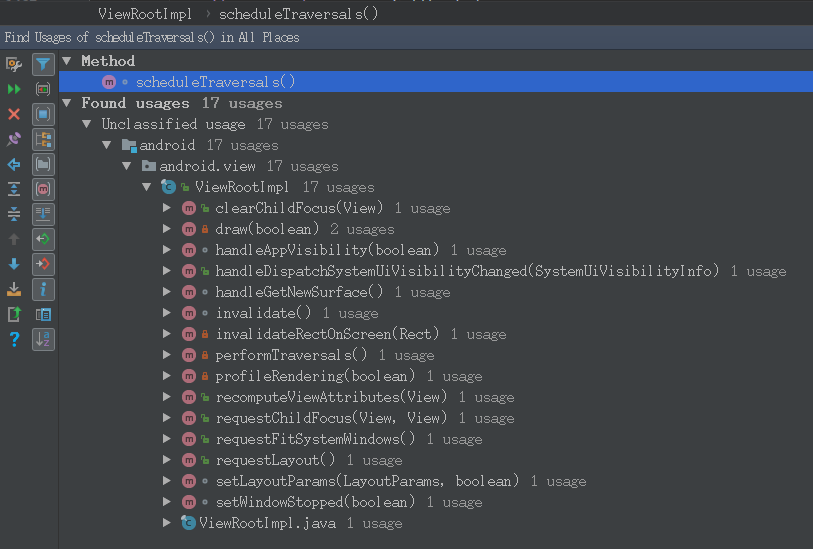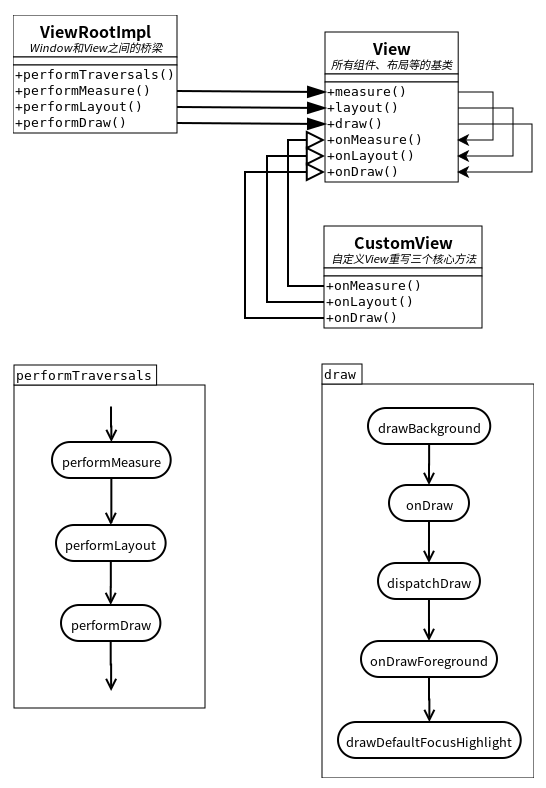Android中View的绘制流程
一、 摘要
介绍Android中View的绘制流程,以及更新视图的两种方法:invalidate和requestLayout。
二、 ViewRootImpl
1. ViewRootImpl是什么
在API文档中如此描述ViewRootImpl:
/**
* The top of a view hierarchy, implementing the needed protocol between View
* and the WindowManager. This is for the most part an internal implementation
* detail of {@link WindowManagerGlobal}.
*
* {@hide}
*/
- View层次结构的顶层。
- 在view和WindowManager之间实现所需的协议。
- WindowManagerGlobal的内部实现细节。
简而言之,ViewRootImpl起到了一个从WindowManager到View的桥梁作用。因此我们先从ViewRootImpl讲起。
2. ViewRootImpl的具体流程
2.1. performTraversals
一个核心的方法:performTraversals,我们通过方法调用倒推:
performTraversals <- doTraversal <- TraversalRunnable <- scheduleTraversals
而这个scheduleTraversals,进行搜索可以发现,它在ViewRootImpl的很多事件中都有调用,这些事件包括对View变化的处理(可以看到有我们熟悉的两个刷新视图的方法invalidate和requestLayout):

因此我们要从performTraversals下手分析。
在源码中,performTraversals有超过800行代码,所以这里直接讲解其中的关键点:
private void performTraversals() {
// 后面可能出现名为host的实例,这个实例其实就是此ViewRootImpl中的View实例
final View host = mView;
// 中间包含了很多方法不是初始化时执行的,而是当视图发生变化需要重新绘制时调用的,可以通过if中条件的改变情况了解
// 处理View的宽高约束条件,即MATCH_PARENT、WRAP_CONTENT或具体长度
int childWidthMeasureSpec = getRootMeasureSpec(mWidth, lp.width);
int childHeightMeasureSpec = getRootMeasureSpec(mHeight, lp.height);
performMeasure(childWidthMeasureSpec, childHeightMeasureSpec);
/**
* 特意列出这部分,在此处理LayoutParams布局参数的权重,即线性布局中设置的weight值,进行二次测量,并向子组件分发,
* 这将对UI的加载造成很大的额外负担,从而降低UI的渲染效率,因此在Android性能优化中,建议开发者尽可能避免使用权重
*/
if (lp.horizontalWeight > 0.0f) {
width += (int) ((mWidth - width) * lp.horizontalWeight);
childWidthMeasureSpec = MeasureSpec.makeMeasureSpec(width,
MeasureSpec.EXACTLY);
measureAgain = true;
}
if (lp.verticalWeight > 0.0f) {
height += (int) ((mHeight - height) * lp.verticalWeight);
childHeightMeasureSpec = MeasureSpec.makeMeasureSpec(height,
MeasureSpec.EXACTLY);
measureAgain = true;
}
if (measureAgain) {
if (DEBUG_LAYOUT) Log.v(mTag,
"And hey let's measure once more: width=" + width
+ " height=" + height);
performMeasure(childWidthMeasureSpec, childHeightMeasureSpec);
}
// 将视图布置在正确位置
performLayout(lp, mWidth, mHeight);
// 绘制视图的内容
performDraw();
}
2.2. performMeasure
在这个方法中,通过WindowManager和各种参数形成一个约束,通过View的measure方法向下传递,让View去获得最终宽高:
mView.measure(childWidthMeasureSpec, childHeightMeasureSpec);
为什么此处不能获得具体宽高呢?举个例子,当前View包含了一些子View,当前View设置为WRAP_CONTENT,那么是不是就必须先获得子View的宽高后,才能得到当前View的宽高了呢?同样的,如果使用线性布局+权重值的方式设置宽高,也无法在此时获得准确值。
2.3. performLayout
在这个方法中,入参的布局参数包含了视图的坐标,再加上另两个参数宽高,便可以定位视图,通过View的layout方法向下传递并设置:
host.layout(0, 0, host.getMeasuredWidth(), host.getMeasuredHeight());
读者可能会觉得奇怪,为什么前两个参数是0?因为这四个参数其实并不是绝对坐标,而是相对父组件的相对坐标,具体分析将在后面讲解。
2.4. performDraw
这个方法中,做了很多复杂的操作,我们关心的draw具体实现的调用,绕了一些远路,首先通过
boolean canUseAsync = draw(fullRedrawNeeded);
调用draw这个方法,然后通过
if (!drawSoftware(surface, mAttachInfo, xOffset, yOffset, scalingRequired, dirty, surfaceInsets))
调用drawSoftware这个方法,最后再通过
mView.draw(canvas);
调用视图绘制的具体方法。
三、 View
1. View是什么
/**
* This class represents the basic building block for user interface components. A View
* occupies a rectangular area on the screen and is responsible for drawing and
* event handling. View is the base class for <em>widgets</em>, which are
* used to create interactive UI components (buttons, text fields, etc.). The
* {@link android.view.ViewGroup} subclass is the base class for <em>layouts</em>, which
* are invisible containers that hold other Views (or other ViewGroups) and define
* their layout properties.
*/
- View是UI组件的基本构建块。
- View在屏幕上占据一个矩形区域(所以我们想要各种不规则形状,都应该在View的绘制阶段实现),负责绘图和事件处理。
- View是小部件的基类,小部件用于创建交互式UI组件(例如按钮Button、文本字段TextView等)。
- ViewGroup子类是布局的基类,布局是不可见的容器,包含其他View(或其他ViewGroup)并定义它们的布局属性(即各种Layout容器)。
2. View中的核心方法
2.1. measure
/**
* <p>
* This is called to find out how big a view should be. The parent
* supplies constraint information in the width and height parameters.
* </p>
*
* <p>
* The actual measurement work of a view is performed in
* {@link #onMeasure(int, int)}, called by this method. Therefore, only
* {@link #onMeasure(int, int)} can and must be overridden by subclasses.
* </p>
*
*
* @param widthMeasureSpec Horizontal space requirements as imposed by the
* parent
* @param heightMeasureSpec Vertical space requirements as imposed by the
* parent
*
* @see #onMeasure(int, int)
*/
public final void measure(int widthMeasureSpec, int heightMeasureSpec) {...}
- 通过入参的约束条件,我们可以计算得到View的实际大小。
- measure会调用onMeasure并在其中实现具体的测量工作。
- onMeasure必须被子类重写。
2.2. layout
/**
* Assign a size and position to a view and all of its
* descendants
*
* <p>This is the second phase of the layout mechanism.
* (The first is measuring). In this phase, each parent calls
* layout on all of its children to position them.
* This is typically done using the child measurements
* that were stored in the measure pass().</p>
*
* <p>Derived classes should not override this method.
* Derived classes with children should override
* onLayout. In that method, they should
* call layout on each of their children.</p>
*
* @param l Left position, relative to parent
* @param t Top position, relative to parent
* @param r Right position, relative to parent
* @param b Bottom position, relative to parent
*/
@SuppressWarnings({"unchecked"})
public void layout(int l, int t, int r, int b) {...}
- 为View及其所有子View分配大小和位置。
- 这是布局机制的第二阶段。(第一阶段即measure)。在这个阶段,每个父元素调用它的所有子元素的layout来定位它们。
- 这通常是使用存储在measure pass()中的子度量来完成的。
- 派生类不应重写此方法,而应该重写onLayout。在onLayout中,他们应该调用每个子元素的layout。
- 四个入参均为相对父View的位置。
- layout中会调用onLayout。
2.3. draw
/**
* Manually render this view (and all of its children) to the given Canvas.
* The view must have already done a full layout before this function is
* called. When implementing a view, implement
* {@link #onDraw(android.graphics.Canvas)} instead of overriding this method.
* If you do need to override this method, call the superclass version.
*
* @param canvas The Canvas to which the View is rendered.
*/
@CallSuper
public void draw(Canvas canvas) {...}
- 手动将此视图(及其所有子视图)呈现到给定画布。
- 在调用此方法之前,View必须已经完成了完整的布局(前一个阶段layout)。
- 在实现View时,实现onDraw这个方法,不要重写本方法。
- 如果确实需要重写本方法,请调用父类的具体实现。
- draw中会调用onDraw。
draw中的绘制步骤为(跳过非必须的两步):
(1) Draw the background
drawBackground(canvas);
(2) Draw view’s content
onDraw(canvas);
(3) Draw children
dispatchDraw(canvas);
(4) Draw decorations
onDrawForeground(canvas);
(5) Draw highlight
drawDefaultFocusHighlight(canvas);
四、 整体绘制流程

五、 更新视图
更新视图有两种方式:invalidate和requestLayout。下面分别对这两种方式进行介绍。
1. invalidate
在class注释中这样描述到:
/**
* To force a view to draw, call {@link #invalidate()}.
*/
可知该方法与视图的draw阶段有关。
再看invalidate的注释:
/**
* Invalidate the whole view. If the view is visible,
* {@link #onDraw(android.graphics.Canvas)} will be called at some point in
* the future.
* <p>
* This must be called from a UI thread. To call from a non-UI thread, call
* {@link #postInvalidate()}.
*/
public void invalidate() {...}
- 让整个视图作废。
- 如果视图可见,接下来将调用onDraw()这个方法对Canvas对象进行绘制。
- 必须在UI线程调用该方法,如果要在非UI线程,应该使用postInvalidate()。
沿着invalidate的调用栈,我们追查到了View中的这个方法:
void invalidateInternal(int l, int t, int r, int b, boolean invalidateCache, boolean fullInvalidate) {
// ...
final ViewParent p = mParent;
if (p != null && ai != null && l < r && t < b) {
final Rect damage = ai.mTmpInvalRect;
damage.set(l, t, r, b);
p.invalidateChild(this, damage);
}
// ...
}
这里的mParent,需要特别注意,在Android的视图模型中,整个UI基于Window之上,这个Window之上首先是前面讲到的ViewRootImpl,ViewRootImpl之上是DecorView,它是一个特殊的View,我们将在后面专门用一篇文章进行讲解,DecorView包含两个部分,ActionBar和ContentParent,ContentParent就是我们xml文件的根节点对应的layout,它是一个ViewGroup。
再回过头来看p.invalidateChild(),由于当前的View可能是普通的View,其mParent是ViewGroup,也可能当前的View已经是DecorView,那么它的mParent就是ViewRootImpl。
我们先来看ViewGroup中的invalidateChild():
@Override
public final void invalidateChild(View child, final Rect dirty) {
ViewParent parent = this;
// ...
do {
View view = null;
if (parent instanceof View) {
view = (View) parent;
}
if (drawAnimation) {
if (view != null) {
view.mPrivateFlags |= PFLAG_DRAW_ANIMATION;
} else if (parent instanceof ViewRootImpl) {
((ViewRootImpl) parent).mIsAnimating = true;
}
}
// ...
parent = parent.invalidateChildInParent(location, dirty);
// ...
} while (parent != null);
}
通过代码也能看出,此时当前的parent有ViewGroup和ViewRootImlp两种情况,先看ViewGroup中的invalidateChildInParent():
@Override
public ViewParent invalidateChildInParent(final int[] location, final Rect dirty) {
if ((mPrivateFlags & (PFLAG_DRAWN | PFLAG_DRAWING_CACHE_VALID)) != 0) {
// ...
return mParent;
}
return null;
}
通过这两部分代码可知,在do-while循环体内,会一直递归去找parent,什么时候为null呢?找到parent为ViewRootImpl时,就停下来了,于是看ViewRootImpl中:
/**
* 在刚才的View.invalidateInternal中,如果mParent是一个ViewRootImpl,则直接到了这里
*/
@Override
public void invalidateChild(View child, Rect dirty) {
invalidateChildInParent(null, dirty);
}
/**
* ViewGroup中通过递归会直接到这里
*/
@Override
public ViewParent invalidateChildInParent(int[] location, Rect dirty) {
// ...
if (dirty == null) {
invalidate();
return null;
} else if (dirty.isEmpty() && !mIsAnimating) {
return null;
}
// ...
invalidateRectOnScreen(dirty);
return null;
}
private void invalidateRectOnScreen(Rect dirty) {
// ...
if (!mWillDrawSoon && (intersected || mIsAnimating)) {
scheduleTraversals();
}
}
我们看到了在第二章讲述ViewRootImpl的具体流程时说的scheduleTraversals()。现在回到performTraversals()中,结合之前的绘制流程:
private void performTraversals() {
// ...
boolean layoutRequested = mLayoutRequested && (!mStopped || mReportNextDraw);
// ...
boolean windowShouldResize = layoutRequested && windowSizeMayChange
&& ((mWidth != host.getMeasuredWidth() || mHeight != host.getMeasuredHeight())
|| (lp.width == ViewGroup.LayoutParams.WRAP_CONTENT &&
frame.width() < desiredWindowWidth && frame.width() != mWidth)
|| (lp.height == ViewGroup.LayoutParams.WRAP_CONTENT &&
frame.height() < desiredWindowHeight && frame.height() != mHeight));
// ...
if (mFirst || windowShouldResize || insetsChanged || viewVisibilityChanged || params != null || mForceNextWindowRelayout) {
// ...
if (!mStopped || mReportNextDraw) {
if (focusChangedDueToTouchMode || mWidth != host.getMeasuredWidth()
|| mHeight != host.getMeasuredHeight() || contentInsetsChanged ||
updatedConfiguration) {
// ...
performMeasure(childWidthMeasureSpec, childHeightMeasureSpec);
// ...
layoutRequested = true;
}
}
}
// ...
final boolean didLayout = layoutRequested && (!mStopped || mReportNextDraw);
// ...
if (didLayout) {
performLayout(lp, mWidth, mHeight);
// ...
}
// ...
performDraw();
// ...
}
private void performDraw() {
// ...
draw(fullRedrawNeeded);
// ...
}
private void draw(boolean fullRedrawNeeded) {
// ...
final Rect dirty = mDirty;
// ...
if (!dirty.isEmpty() || mIsAnimating || accessibilityFocusDirty) {
// ...
if (!drawSoftware(surface, mAttachInfo, xOffset, yOffset, scalingRequired, dirty)) {
return;
}
}
// ...
}
从这里可以看出:
- 调用performMeasure()的前提条件之一是layoutRequested为true。
- 当视图的尺寸属性发生了变化后,才会调用performMeasure()。
- 调用performLayout()的前提条件是调用了performMeasure()。
- 最初在View.invalidateInternal传入的damege,即此处的mDirty,不为空,因此才能够执行后面的drawSoftware中的mView.draw()。
在前一次绘制流程正常执行结束后,layoutRequested变成了false,因此,如果我们的View只有渲染内容改变,调用invalidate最后只有ViewRootImpl.performDraw()会调用,即:View中的draw()会执行。
现在,我们可以得出一个结论,仅在内容改变的情况下,应当使用View.invalidate()去更新视图。
2. requestLayout
在class注释中这样描述到:
/**
* To initiate a layout, call {@link #requestLayout}. This method is typically
* called by a view on itself when it believes that is can no longer fit within
* its current bounds.
*/
用于初始化布局,当视图现有的边界不适用时,就应该调用该方法。
再看requestLayout的注释:
/**
* Call this when something has changed which has invalidated the
* layout of this view. This will schedule a layout pass of the view
* tree. This should not be called while the view hierarchy is currently in a layout
* pass ({@link #isInLayout()}. If layout is happening, the request may be honored at the
* end of the current layout pass (and then layout will run again) or after the current
* frame is drawn and the next layout occurs.
*
* <p>Subclasses which override this method should call the superclass method to
* handle possible request-during-layout errors correctly.</p>
*/
@CallSuper
public void requestLayout() {
// ...
if (mParent != null && !mParent.isLayoutRequested()) {
mParent.requestLayout();
}
// ...
}
- 视图的布局无效时调用此方法。
- 此方法将应用到整个视图树。
- 当视图正在进行布局时(可通过isInLayout()判断),不应调用此方法。
- 如果正在布局时调用此方法,将在当前布局过程结束后再次布局,或者下一次绘制布局过程中执行。
- 子类重写此方法时应该调用该超类的具体实现。
同样的,该方法中的mParent也有ViewGroup和ViewRootImpl两种情况,在ViewGroup中,没有对该方法进行重写,因此mParent.requestLayout()也是调用的View中的requestLayout(),最终会递归调用到ViewRootImpl.requestLayout():
@Override
public void requestLayout() {
if (!mHandlingLayoutInLayoutRequest) {
checkThread();
mLayoutRequested = true;
scheduleTraversals();
}
}
除了scheduleTraversals()这个方法,还多了一个mLayoutRequested = true,然后我们看performTraversals()中:
private void performTraversals() {
// ...
boolean layoutRequested = mLayoutRequested && (!mStopped || mReportNextDraw);
// ...
boolean windowShouldResize = layoutRequested && windowSizeMayChange
&& ((mWidth != host.getMeasuredWidth() || mHeight != host.getMeasuredHeight())
|| (lp.width == ViewGroup.LayoutParams.WRAP_CONTENT &&
frame.width() < desiredWindowWidth && frame.width() != mWidth)
|| (lp.height == ViewGroup.LayoutParams.WRAP_CONTENT &&
frame.height() < desiredWindowHeight && frame.height() != mHeight));
// ...
if (mFirst || windowShouldResize || insetsChanged || viewVisibilityChanged || params != null || mForceNextWindowRelayout) {
// ...
if (!mStopped || mReportNextDraw) {
if (focusChangedDueToTouchMode || mWidth != host.getMeasuredWidth()
|| mHeight != host.getMeasuredHeight() || contentInsetsChanged ||
updatedConfiguration) {
// ...
performMeasure(childWidthMeasureSpec, childHeightMeasureSpec);
// ...
layoutRequested = true;
}
}
}
// ...
final boolean didLayout = layoutRequested && (!mStopped || mReportNextDraw);
// ...
if (didLayout) {
performLayout(lp, mWidth, mHeight);
// ...
}
// ...
performDraw();
// ...
}
private void performDraw() {
// ...
draw(fullRedrawNeeded);
// ...
}
private void draw(boolean fullRedrawNeeded) {
// ...
final Rect dirty = mDirty;
// ...
if (!dirty.isEmpty() || mIsAnimating || accessibilityFocusDirty) {
// ...
if (!drawSoftware(surface, mAttachInfo, xOffset, yOffset, scalingRequired, dirty)) {
return;
}
}
// ...
}
由上一节可知:
- 此时layoutRequested为true,如果View的尺寸有变化,那就会执行performMeasure()和performLayout()。
- 由于没有传入dirty实例,此处的mDirty为空,也就不会执行后续drawSoftware中的mView.draw()。
至此,我们得出第二个结论,仅当视图的尺寸发生变化时,应该调用View.requestLayout()去更新。
3. 总结
- 当View的内容发生变化时,应当调用View.invalidate()去更新视图。
- 当View的尺寸发生变化时,应当调用View.requestLayout()去更新视图。
- 当View的内容和尺寸都发生变化时,(按照绘制流程顺序)应当先调用View.requestLayout()再调用View.invalidate()去更新视图。
